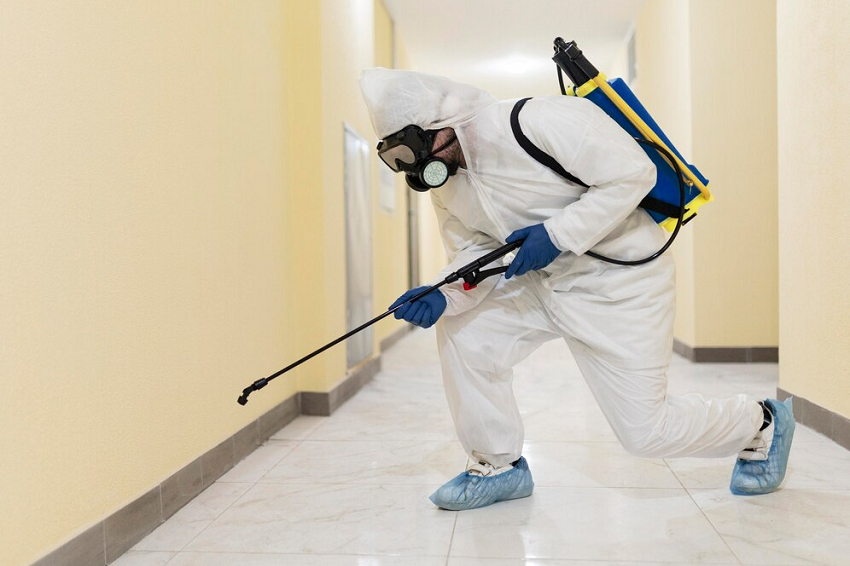Silent destroyers and termites in walls can weaken your home structure before you know they are present. They prefer dark, damp spaces, which means your walls become a great breeding ground for them. Unattended termite infestation leads to severe wall damage that requires expensive restorations. Proper treatment methods exist both for termite elimination and to stop new infestations. To treat termites in walls, you need to engage a professional termite control firm to come and evaluate the situation before applying the right measures like baiting, chemical treatments, or spot fumigation.
This guide will present how to treat termites including termite detection methods and preventative measures that defend your walls against termites. The key to eliminating wall termite problems consists of boric acid DIY products and essential oils together with professional liquid termiticides and baiting systems that provide the ultimate solution.
The guide explains direct steps to protect your property when you have termite infestation problems or when you want to prevent termite attacks. The following guide provides instructions about termite identification and damage prevention techniques that prevent future infestations.
Signs of Termites in Walls
Termite can cause serious damage to your home before you even notice them. Detecting early signs is essential to prevent costly repairs. One major indicator is hollow-sounding wood—tap on your walls, and if they sound empty, termites may be feeding inside.
Another sign is mud tubes along walls or baseboards, which termites use for protection. You may also notice discarded wings near windows and doors, a sign of swarmer looking to establish a colony.
Bubbling or peeling paint can indicate moisture buildup from termite activity. Small pinholes in drywall or faint clicking sounds from inside the walls are also red flags. Professional termite inspection serves two functions by documenting infestation and selecting the most effective treatment methods.
Resourceful termite detection at an early stage allows homeowners to minimize irreversible damage to their homes. The following signs provide important indicators regarding conditions in your walls.
- Hollow-Sounding Wood: Tap on your walls with a screwdriver or hammer. You will find a hollow sound when knocking on wood which suggests termites have hollowed out the interior.
- Mud Tubes: Termites construct mud tubes because these structures enable them to reach their sources of food from their colony. Mud tubes with the equivalent diameter of a pencil are normally present along foundation areas or walls and other nearby frameworks.
- Discarded Wings: After swarming, termites shed their wings. Finding piles of tiny wings near windowsills or walls is a clear indicator of termite activity.
- Frass: Terms produce droppings that appear as wood-colored pellets known as frass. Frass located near your walls indicates a termite infestation.
- Cracked or Bubbling Paint: Termite infestations on walls cause both surface bubbling and cracked paint.
- Sagging Floors or Ceilings: Serious termite damage can lead to structural issues that cause ceilings and floors to sag.
Termites can stealthily live in the walls of a house and in a stealthy manner gradually consume the internal wall surfaces of the structure. Signs that such a problem is ongoing include large swarms of flying ants coming out from certain gaps. This problem, if resolved quickly and accompanied by preventive measures allows walls to become impenetrable to future attacks by damaging insects like termites.
How to Treat Termites in Walls

Keep in mind the best termite defense is a good offense. Keeping your home termite-free can be achieved with regular inspections, controlling moisture, and preventative treatments. So, If you suspect that termites have entered your walls, don’t sit idly and wait! It’s time to take action to treat termites.
1. Identify the Type of Termite
Property destruction from termites happens unbeknownst to homeowners until it becomes too advanced to repair. Starting an effective termite control operation begins by correctly identifying the termite infestation present. The correct identification of different species remains vital because each one needs a specific treatment methodology.
Termites with subterranean characteristics constitute the most prevalent types because they exist beneath ground layers when constructing mud tubes to obtain their food. Professional treatment methods must be used against these highly destructive terms because of their nature.
The correct understanding of their behavior and habitat will enable you to take suitable measures that both eliminate termites effectively and prevent costly damage to your home.
- Drywood Termites: Drywood Termites attack dry wood structures since they need neither contact with soil nor moisture for their survival. Most of these termites inhabit furniture structures along with inside walls and they reside in attic spaces.
- Damp wood Termites: Damp wood Termites prefer moist wood environments which they inhabit within rotting and wet woods.
To pick the best solution for termite treatment you need proper identification of the affected pests.
2. Use Termite Baits
Without proper control methods, the termite infestation causes significant damage to building structures. The most effective method to destroy termite colonies requires using termite bait.
Termite baiting systems function through attracting these pests to poison which they transport to their colony thus ending the entire group in time. At their homes termite baits reach termites more effectively than chemical sprays since they work directly at their foundation to provide enduring termite management.
You should follow some instructions about using termite baits to achieve the best protection against termites in your home. The correct procedure for using termite baits consists of the following steps:
- Place the Baits: Bait stations need placement by your home in locations displaying termite behavior observations. Users need to read and follow the directions stated by the manufacturer to install their product correctly.
- Monitor the Baits: Check the bait stations frequently to ensure they are consumed by termites. Replace baits, as necessary.
- Waiting for Results: The whole colony might take several weeks or months to die after applying for the bait. Wait patiently.
3. Apply Liquid Termiticides
Homeowners dread termite infestations because the resulting damage to house infrastructure becomes very expensive. The effective elimination of pests occurs through the usage of liquid termiticides.
The chemicals create two functions: they eliminate termites that meet the treatment while building an obstacle zone that stops new termite colonies. Individuals need to choose appropriate liquid termiticides from their product range depending on termite types during proper application methods.
For using liquid termiticides you need to follow these step by step. Choose the right product: Now select the chemical termiticide according to the type of termite.
- Drill and Treat: Drill small holes into the infested walls and inject the termiticide directly into the termite galleries. This method attacks the termites where they live and feed.
- Create a Barrier: Apply the termiticide around the perimeter of your home to create a protective barrier that prevents termites from entering.
4. Foam Termiticides
Foam termiticides are a powerful solution for tackling hidden termite infestations. Designed to expand and fill hard-to-reach spaces like wall voids, crawl spaces, and termite galleries, these foams ensure thorough coverage, effectively eliminating colonies.
Homeowners dread termite infestations because the resulting damage to house infrastructure becomes very expensive. The effective elimination of pests occurs through the usage of liquid termiticides. The chemicals create two functions: they eliminate termites that meet the treatment while building an obstacle zone that stops new termite colonies.
You need to choose appropriate liquid termiticides from their product range depending on termite types during proper application methods. Here’s how to apply foam termiticides:
- Drill Access Holes: Drill small holes at the wall infusion to get access into the galleries.
- Inject the Foam: Using a foam applicator, inject the termiticide foam into the holes. The foam will expand and spread throughout the galleries.
- Seal the Holes: Once the foam has been applied, seal the holes to prevent termites from escaping.
5. Call a Professional Exterminator
It’s better to hire an exterminator if you have a significant infestation or don’t know how to get rid of termites from your walls. Professional exterminators have the knowledge, expertise, and tools necessary to eradicate termites and stop them from coming back. It becomes tough to handle and missing even a few termites can lead to more damage.
They will inspect your house, locate those problem areas, and use the best possible treatment to keep your house safe. A comprehensive examination, the identification of impacted areas, and the application of focused treatment techniques such as liquid termiticides or baiting systems are usually included in a professional termite treatment.
To keep your home safe over time, exterminators may also recommend preventative measures. You can be sure that the infestation will be handled skillfully by contacting a professional, giving you peace of mind and shielding your property from further damage.
- Inspection: To determine the kind of termites you have and the extent of the issue, the exterminator will do a thorough inspection of your house.
- Treatment Plan: After the inspection, they will make a treatment plan suitable for your case.
- Follow-Up: The exterminator may come back to your house after the treatment to ensure all the termites are eliminated if necessary.
Preventing Future Termite Infestations
Preventing new infestations is crucial after treating termites in walls. The following advice will help you avoid problems:
1. Remove Moisture
The main attraction of moisture, so let’s keep the home dry.
- Fix Leaks: Repair any leaking pipes, faucets, or roofs to remove moisture sources.
- Improve Drainage: Install downspouts and gutters to help divert water from the foundation.
Beginning in December, ventilating crawl spaces and attics to bring humidity levels down.
2. Remove Wood-to-Soil Contact
Regular inspections can detect termite activity early and avoid a problem before it becomes significant. Here’s what to do:
- Use Concrete Bases: Get your home inspected for termites by professionals at least once a year.
- Store Firewood Properly: Be on the lookout for signs of termites, like mud tubes, shed wings, or wood that sounds hollow when tapped.
3. Regular Inspections
Regular inspections can catch termite activity early before it becomes a significant problem. Here’s what to do:
- Schedule Annual Inspections: At least once a year, get a professional termite inspection of your house.
- Monitor for Signs: Look for termite-related debris, such as mud tubes, abandoned wings, or wood that sounds hollow.
4. Use Termite-Resistant Materials
Use termite-resistant material in building or reconstruction. For instance, make use of the following materials:
- Treated Wood: Use pressure-treated wood, which is wood that is treated with certain termite-resistant chemicals.
- Concrete or Steel: Using steel or concrete for structural portions can be another way to bypass wood.
5. Preventive Treatments
Preventive treatments could form a kind of barrier that does not allow termites to enter your house. Here is how:
- Soil treatment: Liquid termiticide inserted around the home’s foundation to create a protective barrier.
- Wood treatment: Treat wood with a special termite-resistant varnish to discourage the termites from nesting in the wooden structures.
Conclusion
If termites in walls are not removed right away, they may cause serious structural damage. It’s critical to spot early warning indicators, such mud tubes, hollow-sounding wood, or abandoned wings, to stop additional damage.
For minor infestations, DIY solutions like boric acid, bait stations, or essential oils can help eliminate termites. The nervous system of termites becomes compromised through contact with boric acid and colonies get poisoned when termites enter bait stations. Diatomaceous earth proves to be an effective control method by dehydrating the termites until they die.
A large-scale termite infestation requires professional extermination services. The experts suggest applying fumigation alongside building the termiticide barriers and conducting heat treatments. The protective barrier from liquid termiticides protects the area but fumigation eliminates termites that hide within walls. The professionals employ alternative methods that include nematode applications that feed on the termites.
Precautionary steps exist to decrease the possibility of termite reentry. The prevention of termite infestation needs frequent inspections together with proper moisture management and sealed access points. Your wood protection from termites can include using termite-resistant coatings while firewood should stay at a safe distance from your house.
Fast action along with correct treatment options allows homeowners to defend their homes from expensive termite-related damage. When you think pest infestation exists you must speak with an expert pest controller to gain an effective long-lasting solution.


